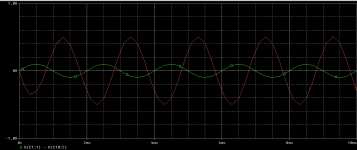I need it to be 100, if that's even possible here.How much bigger ?
i suppose it is to reduce the noise? not sure I am pretty new to thisJust a cursory peek. What is the point of the boostrapped follower on the input?
Bootstrapping in this circuit raises the input impedance. That's of little use in the input stage of an audio pre-amp.i suppose it is to reduce the noise? not sure I am pretty new to this
Your better off using a couple of Op-amps and copying an established design.
It's a uni project, i don't know why they want a 40dB gainLook elsewhere. Do you really need tone controls?
Why would you need 40dB gain in a line stage?
15V supply voltage, 25mV alternating input voltage, frequency band between 500Hz and 15kHz, neutral central frequency 5kHz at tone correction, +-15dB correction, voltage gain at neutral frequency 100, output resistance 600 ohmsList the complete project requirements that are specified.
Can you use op amps, or is discrete circuitry required?
The power supply must be +15V / 0V ?
Or can it be +15V / 0V / -15V ?
The power supply must be +15V / 0V ?
Or can it be +15V / 0V / -15V ?
Unfortunately no, I cannot use op ampsCan you use op amps, or is discrete circuitry required?
The power supply must be +15V / 0V ?
Or can it be +15V / 0V / -15V ?
Yes the power supply can be +15V / 0V / -15V!
The tone stage has unity gain with the tone controls centered. The input stage has unity gain.
To have more than unity voltage gain overall, you need a gain stage at the input, before the follower stage.
Add a gain stage similar to Q2 at the input. However, x100 gain would be difficult to achieve in one bipolar stage.
You may have to use two cascaded x10 gain stages, before the follower stage.
To have more than unity voltage gain overall, you need a gain stage at the input, before the follower stage.
Add a gain stage similar to Q2 at the input. However, x100 gain would be difficult to achieve in one bipolar stage.
You may have to use two cascaded x10 gain stages, before the follower stage.
I will try that, thank you so much I really appreciate it. Can I message you/reply here later today or tomorrow if I still can't figure it out?The tone stage has unity gain with the tone controls centered. The input stage has unity gain.
To have more than unity voltage gain overall, you need a gain stage at the input, before the follower stage.
Add a gain stage similar to Q2 at the input. However, x100 gain would be difficult to achieve in one bipolar stage.
You may have to use two cascaded x10 gain stages, before the follower stage.
Just post here. Has this project ever been assigned before? It is not trivial with discrete components.
The active tone stage must have unity gain.
Just two standard op amps would be adequate otherwise.
The active tone stage must have unity gain.
Just two standard op amps would be adequate otherwise.
No it hasn't, usually they assign an amplifier, oscillator or a stabilizer, so this preamp is something completely new. No documentation or examples other than the requirements I lister earlierJust post here. Has this project ever been assigned before? It is not trivial with discrete components.
The active tone stage must have unity gain.
Just two standard op amps would be adequate otherwise.
This is an old circuit similar to the Sinclair project 60 preamp, except that the Sinclair circuit used two transistors instead of the input follower, and they switched RIAA feedback in and out for phono/Mic/aux inputs. There are issues with these old circuits, but they worked well enough, and the Sinclair preamp is similar to what you have.
http://diy.torrens.org/Sinclair/P60/issue_1/p06.jpg
If you are building something new, I would copy the tone controls but use op-amps instead of discrete amplifier. Setting the gain of an op-amp is a simple matter of selecting the feedback resistors. You could build this entire preamp (two channels) with a single quad op-amp.
http://diy.torrens.org/Sinclair/P60/issue_1/p06.jpg
If you are building something new, I would copy the tone controls but use op-amps instead of discrete amplifier. Setting the gain of an op-amp is a simple matter of selecting the feedback resistors. You could build this entire preamp (two channels) with a single quad op-amp.
Thank you! Unfortunately it's a uni project and I can't use op-ampsThis is an old circuit similar to the Sinclair project 60 preamp, except that the Sinclair circuit used two transistors instead of the input follower, and they switched RIAA feedback in and out for phono/Mic/aux inputs. There are issues with these old circuits, but they worked well enough, and the Sinclair preamp is similar to what you have.
http://diy.torrens.org/Sinclair/P60/issue_1/p06.jpg
If you are building something new, I would copy the tone controls but use op-amps instead of discrete amplifier. Setting the gain of an op-amp is a simple matter of selecting the feedback resistors. You could build this entire preamp (two channels) with a single quad op-amp.
I wonder if the teacher has already designed a discrete circuit that is working to spec.
The 25mV input level is certainly not representative of current practice.
The 25mV input level is certainly not representative of current practice.
The weird thing is that the alternating input voltage might differ between students. Some have it as low as 5mV.I wonder if the teacher has already designed a discrete circuit that is working to spec.
The 25mV input level is certainly not representative of current practice.
- Home
- Source & Line
- Analog Line Level
- Audio preamplifier with tone control

